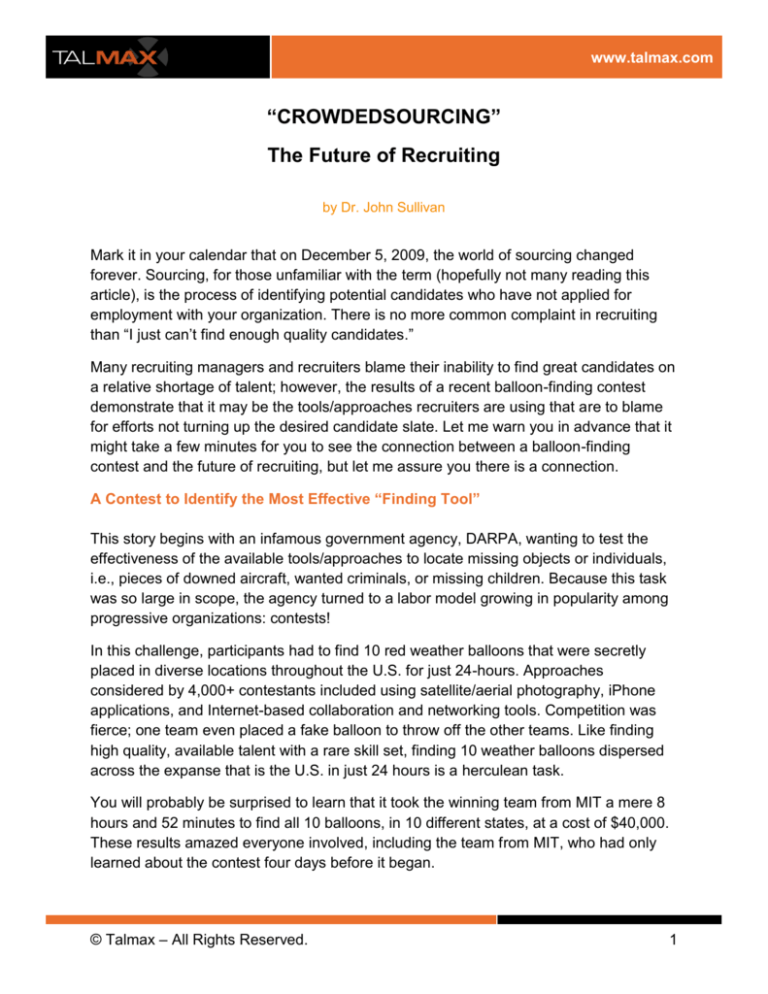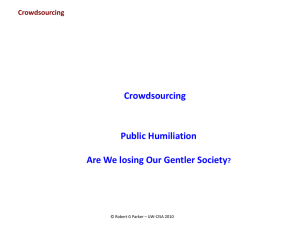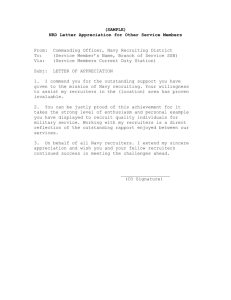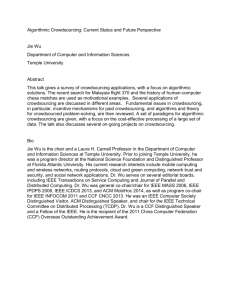
www.talmax.com
“CROWDEDSOURCING”
The Future of Recruiting
by Dr. John Sullivan
Mark it in your calendar that on December 5, 2009, the world of sourcing changed
forever. Sourcing, for those unfamiliar with the term (hopefully not many reading this
article), is the process of identifying potential candidates who have not applied for
employment with your organization. There is no more common complaint in recruiting
than “I just can’t find enough quality candidates.”
Many recruiting managers and recruiters blame their inability to find great candidates on
a relative shortage of talent; however, the results of a recent balloon-finding contest
demonstrate that it may be the tools/approaches recruiters are using that are to blame
for efforts not turning up the desired candidate slate. Let me warn you in advance that it
might take a few minutes for you to see the connection between a balloon-finding
contest and the future of recruiting, but let me assure you there is a connection.
A Contest to Identify the Most Effective “Finding Tool”
This story begins with an infamous government agency, DARPA, wanting to test the
effectiveness of the available tools/approaches to locate missing objects or individuals,
i.e., pieces of downed aircraft, wanted criminals, or missing children. Because this task
was so large in scope, the agency turned to a labor model growing in popularity among
progressive organizations: contests!
In this challenge, participants had to find 10 red weather balloons that were secretly
placed in diverse locations throughout the U.S. for just 24-hours. Approaches
considered by 4,000+ contestants included using satellite/aerial photography, iPhone
applications, and Internet-based collaboration and networking tools. Competition was
fierce; one team even placed a fake balloon to throw off the other teams. Like finding
high quality, available talent with a rare skill set, finding 10 weather balloons dispersed
across the expanse that is the U.S. in just 24 hours is a herculean task.
You will probably be surprised to learn that it took the winning team from MIT a mere 8
hours and 52 minutes to find all 10 balloons, in 10 different states, at a cost of $40,000.
These results amazed everyone involved, including the team from MIT, who had only
learned about the contest four days before it began.
© Talmax – All Rights Reserved.
1
www.talmax.com
The Connection between Finding Balloons and Recruiting
To solve this challenge both DARPA and MIT used a method known as crowdsourcing.
In this case, DARPA used crowdsourcing to staff its initiative, while the MIT team used
crowdsourcing to source information. Crowdsourcing is a term coined for a new form of
labor in which tasks that would have traditionally been allocated to an employee are
instead allocated to an ad hoc formed, undefined group, or crowd.
Crowdsourcing is the labor solution that has been used to build and maintain the
powerhouse online encyclopedia, Wikipedia, as well as numerous other corporate
projects such as the Netflix Prize. To the surprise of many, this DARPA challenge
proved that crowdsourcing is the most effective finding tool on the planet, bar none.
I use Social Media. Why Am I Not Getting These Amazing Results?
Social media usage in recruiting is a hot trend, but very few recruiters are producing
significant results from their efforts. Online forums are abuzz with recruiters who have
tried recruiting via social media and given up, because it simply did not work for them.
Other recruiters laud the success of their efforts, not in recruiting the masses, but in
locating that, one great hire that made them a hero among managers. To those who
have tried and failed, I argue that the tool did not fail, but rather the approach to using
the tool.
Simply being active on Facebook, LinkedIn, Twitter, etc., is not a solution. Social media
recruiting, like all strategic efforts, requires a well-thought-out approach that
incorporates the critical success factors that transform an ordinary effort into an
extraordinary solution.
Ten Critical Success Factors for Effective “Crowdsourcing”
The following is a list of 10 critical success factors to incorporate into crowdsourcing
centric recruiting solutions such as social media efforts and employee referral programs
for them to reach maximum effectiveness.
The Kevin Bacon principle: crowdsourcing and employee referral programs both work
because top performers know, trust, and have relationships with other top performers.
As the scope of program participation grows larger, the probability of identifying all
probable talent increases. The key learning: all organizations should be monitoring the
participation rate of relevant parties in crowdsourcing initiatives, most notably the
participation rate of proven top performers.
© Talmax – All Rights Reserved.
2
www.talmax.com
You must have a plan: if an ad hoc managed effort produces results, it is purely from
luck! Programs capable of producing predictable and repeatable results require a
comprehensive plan and feedback loops that help identify design issues that when
positively addressed can improve program effectiveness.
Leverage the search work through collaboration: the underlying success principle of
any crowdsourcing effort is large-scale collaboration. You cannot reach the critical mass
of individuals required for an effective search if you rely exclusively on recruiters. The
most effective search efforts marshal the time and contacts of anyone and everyone
who can be convinced to help, including your entire employee base, their families,
alumni, vendors, customers, and anyone else who likes your organization. Collaboration
also requires that information flow both ways, so that the crowd does not waste time
sourcing information already found. Just like in a scavenger hunt, learning what the
other teams have already produced can go a long way to helping any particular team
advance.
Rewards drive results: you cannot get widespread collaboration without some kind of
motivating factor. The MIT approach relies heavily on rewards. The reward schema was
an inverted pyramid where 50% of the reward went to the first individual to find the
target, 25% went to the individual who invited that person to participate, and 12.5 % to
whoever invited that person, and so on up to a total of $4,000. In any corporate
crowdsourcing model, you need to reward individuals outside the corporation who
identify top talent. The rewards do not have to be in cash; they could include coffee
cards, offers of free services/products, or even donations to charity.
You will require a broad range of social media outlets: Crowdsourcing works only if
you use every type of available social media outlet. In addition to the commonly used
LinkedIn, Facebook and Twitter use every type of communication and collaboration
mechanism, including SMS, Internet forums, video sharing sites, meet-up groups,
professional associations, etc.
You really need worldwide collaboration: even though the balloons were placed
exclusively within the U.S., the MIT effort would not have been successful without
extensive international participation. It turns out that globally located individuals could
indirectly produce finds by using the segment of their network that was located in the
U.S. For a corporate model to work, it must not limit its social networking to sites and
individuals located in the same country where the job is.
© Talmax – All Rights Reserved.
3
www.talmax.com
A continuous search approach is superior: although crowdsourcing can produce
amazing results in a short time, it is even more effective and less time-consuming if it is
a continuous operation. The best sourcing approaches that target top performers
always begin looking to identify candidates long before a position becomes open (preneed sourcing).
A relationship is required: although identifying top performers is an important first
step, in many cases, you will not be able to convince a top performer to actually apply
for a position without first building a relationship. Learning, benchmarking, and
professional growth rather than the promise of a job are the basis of most effective
relationships.
Expand and revitalize the referral program: in order to be effective, the process for
submitting names and narrowing down the submissions to the very best must be easy
and responsive. The best approach for crowdsourcing is to use the existing employee
referral process, but update it so that it is more effective. Referral program participants
should also be encouraged to pre-assess potential referrals based on their
competencies but also on their fit to the corporation.
Recruiters must be educated: rather than actually doing most of the networking,
recruiters must be educated and rewarded for their role in managing the networking
process. They must become experts in understanding social media collaboration, so
that they can attract more participants, retain the ones they have, and then educate
these participants on how to produce better results.
Final Thoughts
The effectiveness of employee referral programs has historically provided some
evidence to the value of having a large number of individuals looking; however, the
success of the balloon contest should be a wake-up call to all recruiting managers that
social media collaboration can literally be… the future of sourcing.
It is also important to realize that the DARPA contest proves that you must move
beyond the current hodgepodge of uncoordinated social media recruiting efforts toward
the more scientific and more inclusive managed crowdsourcing model. Direct sourcing
is the future, and crowdsourcing is what will make it feasible.
Dr. John Sullivan (JohnS@sfsu.edu) is a well-known thought leader in HR. He is a frequent speaker and advisor to
Fortune 500 and Silicon Valley firms. Formerly the chief talent officer for Agilent Technologies (the 43,000-employee
HP spin-off), he is now a professor of management at San Francisco State University. Dr. Sullivan is known as the
"Michael Jordan of Hiring" by Fast Company magazine. You can find more recruiting articles by Dr. Sullivan in the ER
Daily archives. Information about his numerous other articles, books and manuals about recruiting and HR are
available at www.drjohnsullivan.com. Dr. Sullivan is also the editor of VP of HR, an e-newsletter providing "out of the
box" solutions for senior HR managers
© Talmax – All Rights Reserved.
4





